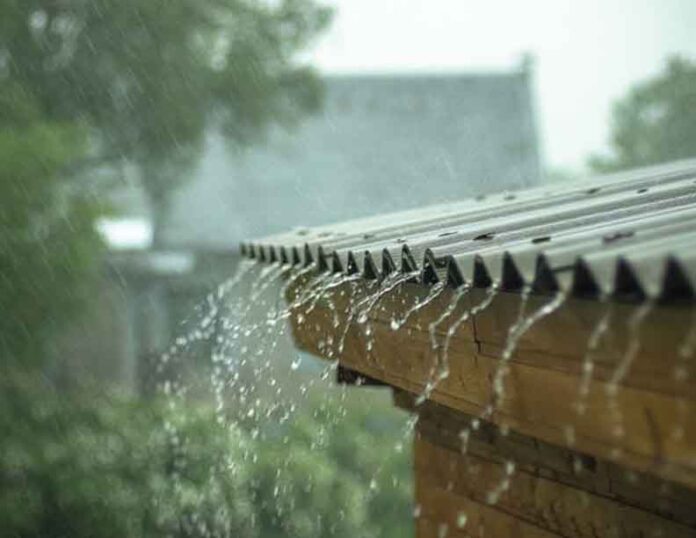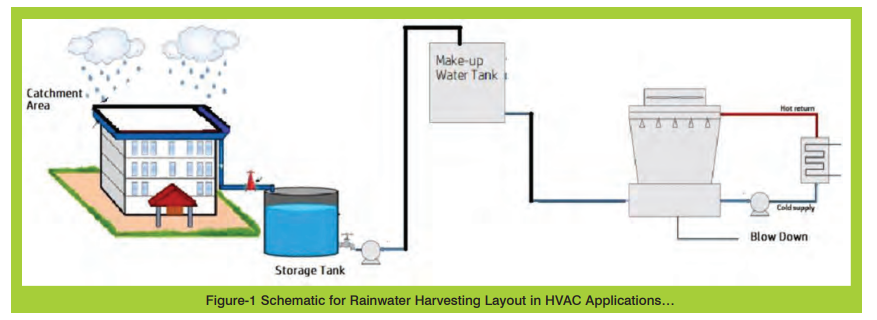
In the realm of water-cooled HVAC systems, which can encompass a variety of configurations such as water-cooled chillers and water-cooled Variable Refrigerant Flow (VRF) systems, a substantial proportion of the water is frequently lost through a trio of primary mechanisms: evaporation, drift losses, and losses that occur during the draining process. These systems are crucial for maintaining the optimal temperature and air quality within the confines of the buildings they serve, yet the inherent water consumption they necessitate can lead to substantial financial burdens in the form of hefty water bills levied by the respective water supply entities.
Step for counteraction
To counteract this issue and promote a more sustainable and environmentally conscious approach to managing the water demands of HVAC systems, the integration of rainwater harvesting has emerged as a highly effective and viable strategy. Rainwater harvesting is a methodology that encompasses the collection, storage, and judicious reuse of precipitation, which naturally falls onto the rooftops and surrounding areas of buildings. This innovative approach not only serves to minimise the reliance on conventional water sources but also presents a multitude of benefits that transcend both ecological and economic realms.
When deliberating the incorporation of rainwater harvesting technology into the existing framework of an HVAC system, it is essential to meticulously consider a plethora of factors to ensure its successful implementation and optimal functionality. These considerations include the following outlined points.
Need for analysis
The initial phase of the process involves conducting a thorough and comprehensive analysis to ascertain the precise and intricate water requirements for the HVAC system, taking into careful consideration the multifaceted needs of various components such as cooling towers, evaporative condensers, and any other auxiliary elements that are fundamentally reliant upon an adequate water supply for the critical functions of thermal rejection and the maintenance of sanitary conditions.

This stage is pivotal in ensuring that the system operates at optimal efficiency and effectiveness, as it requires an in-depth understanding of the specific water demands that are essential to support the complex mechanisms and processes that facilitate the system’s primary objective of temperature regulation.
Effective implementation
To effectively design and implement a rainwater harvesting infrastructure that is meticulously customised to the unique environmental and operational requirements of a given area, it is crucial to develop a collection mechanism that is intricately aligned with the local climate and the magnitude of the Heating, Ventilation, and Air Conditioning (HVAC) system in place.
This comprehensive approach entails the strategic installation of various essential components, such as gutters, downspouts, and a meticulously engineered catchment basin, which are all imperative for the optimal accumulation of rainwater.
Consideration of the unique characteristics
By taking into consideration the distinct characteristics of the regional weather patterns, the specific architecture of the rooftops, and the overall scale of the HVAC setup, a more effective and efficient system can be established.
This tailored rainwater collection solution ensures that the harvested water can be fully utilised, thereby contributing significantly to the reduction of water consumption and the promotion of environmental sustainability. The design process involves a careful analysis of the precipitation rates, the size and shape of the rooftop, the desired capacity of the storage system, and the specific needs of the HVAC system to determine the most appropriate configuration for the collection network. This includes assessing the optimal placement and dimensions of the gutters to efficiently channel water into the downspouts, as well as the most suitable materials and construction techniques to ensure durability and longevity against the elements.
Elements that need inclusion in design
Moreover, the design must incorporate a catchment area that is not only large enough to handle the expected volume of rainwater, but also properly sloped to prevent pooling and potential overflow issues.
Additionally, the integration of filters and pre-treatment measures may be necessary to ensure that the collected water is free from debris and contaminants before it enters the storage system.
This thoughtfully crafted infrastructure can be further enhanced by incorporating advanced technologies such as smart sensors and automated cleaning systems to monitor and maintain the quality of the harvested water, thereby maximising the potential benefits of this eco-friendly resource.
Ultimately, the custom design of rainwater collection systems plays a pivotal role in achieving a more sustainable and self-sufficient water management strategy for buildings equipped with HVAC systems, ensuring that rainwater is collected and utilised in a manner that is both practical and environmentally responsible.
Purification and treatment protocol
Considering the possible presence of contaminants in precipitation, it is imperative to institute an exhaustive purification and treatment protocol. This may encompass the utilisation of sand filtration systems, ultraviolet disinfection technology, or chlorine treatment to eliminate detritus, sediment, and microbiological entities.
Further to the above, it is essential to procure a storage tank with a suitable capacity to retain the accumulated rainwater. The reservoir’s material composition and structural integrity must be consonant with the designated application of the water and engineered to preclude the intrusion of contaminants. Integrate a pumping system that adheres to the necessary flow rate and pressure specifications to ensure the uninterrupted conveyance of rainwater from the storage tank to the HVAC infrastructure.
Quality monitoring
Establish a thorough monitoring regime to systematically assess the quality of the preserved rainwater. This precaution is vital to safeguard the optimal performance of the HVAC system and avert any potential harm that may stem from inadequate water quality.
Understanding of the local legal framework
It is of paramount importance to gain a thorough understanding of the local legal framework governing the utilisation of rainwater within Heating, Ventilation, and Air Conditioning (HVAC) systems. This may necessitate the procurement of appropriate permissions and strict conformity to prescribed design specifications.
Adjustments and enhancement
Modify and optimise the current HVAC (Heating, Ventilation, and Air Conditioning) system framework to efficiently accommodate the integration of rainwater harvesting. This comprehensive process will necessitate a series of strategic adjustments and enhancements, including but not limited to, the meticulous modification of the existing makeup water lines. This modification will serve to create an optimised pathway for the rainwater to be directed and utilised within the HVAC system.
Moreover, the implementation of isolation valves will be a crucial component of this upgrade. These valves will be installed at key junctures to allow for the effective segregation and management of the rainwater, thereby preventing any potential cross-contamination with the system’s existing water sources. This will also enable the smooth transition between the use of rainwater and traditional water sources, as and when required, without compromising the performance or the integrity of the HVAC system.
Compatibility with the HVAC infrastructure
Another significant aspect of this integration is ensuring that the rainwater is compatible with the chemical requirements of the HVAC infrastructure. This involves a thorough analysis and understanding of the rainwater’s properties, including its pH levels, mineral content, and potential impurities. Based on these findings, appropriate filtration and treatment measures may need to be employed to align the rainwater with the system’s specifications, thereby preventing any damage or malfunction of the HVAC components and maintaining their longevity.
Additionally, the system’s existing water treatment protocols might need to be revised to account for the unique characteristics of rainwater. This could encompass the introduction of new chemical treatments or the adjustment of existing regimens to ensure that the water is suitable for use within the HVAC framework without causing corrosion, scaling, or other detrimental effects. It is essential to conduct regular monitoring and maintenance checks to verify the rainwater’s chemical compatibility and the system’s overall performance post-integration.
Furthermore, the integration of rainwater into the HVAC system can also present an opportunity to enhance its energy efficiency and environmental sustainability. By leveraging the natural resource of rainwater, the reliance on conventional water sources can be reduced, which in turn decreases the strain on local water supplies and contributes to lower operational costs. The design and execution of this integration must be carefully planned and executed to maximize these benefits while adhering to all relevant safety and regulatory standards.
Summary
In summary, the adaptation of the current HVAC infrastructure for rainwater integration involves a multi-faceted approach that includes modifying makeup water lines, installing isolation valves, and ensuring the rainwater’s chemical compatibility. This endeavour not only supports water conservation efforts but also has the potential to enhance the system’s overall performance and sustainability profile.
Conduct a financial analysis to determine the cost-effectiveness of integrating rainwater into the HVAC system. This should factor in the initial investment, operational cost savings, and any potential incentives or rebates associated with water conservation efforts.
Employ sophisticated automated control systems to oversee the rainwater collection process with meticulous accuracy. These systems may be equipped with sensors designed to initiate a switch to alternative water sources upon reaching the storage tank’s capacity limit, and concurrently, they can produce alerts to indicate any impending maintenance requirements.
By adhering to these guidelines, the application of rainwater harvesting in HVAC systems can result in a significant reduction in water consumption, lower utility costs, and contribute to a more sustainable environmental footprint for the building in question.
By carefully evaluating these considerations, property owners and managers can make informed decisions regarding the integration of rainwater harvesting within their HVAC systems. This strategic move not only promises to alleviate the financial strain associated with high water consumption but also contributes to the broader objective of environmental stewardship by reducing water waste and conserving precious resources. In essence, the adoption of rainwater harvesting within the HVAC domain represents a win-win scenario, offering substantial savings alongside a positive contribution to the health of the environment.

J. Jiwani is a post graduate mechanical engineer from IIT Delhi, a fellow of Institution of Engineers (India) and a chartered engineer. He pursued his career as an HVAC consultant since 1985 onwards in the Vidarbha region. He is regarded as a prominent icon for ventilation systems and evaporative cooling systems. He is the Founder President of ISHRAE Nagpur chapter. He has been conferred with Lifetime Service Award and honoured with the title Chapter President Emeritus by ISHRAE.








